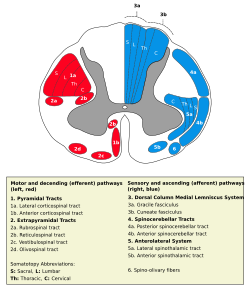Extrapyramidal system: Difference between revisions
m Reverted edits by 68.113.179.139 to last revision by ClueBot (HG) |
No edit summary |
||
| Line 19: | Line 19: | ||
DorlandsSuf = 12787420 | |
DorlandsSuf = 12787420 | |
||
}} |
}} |
||
In [[human anatomy]], the '''extrapyramidal system''' is a [[neural network]] located in the [[human brain|brain]] that is part of the [[motor system]] involved in the coordination of movement. The system is called "extrapyramidal" to distinguish it from the tracts of the motor cortex that reach their targets by traveling through the "pyramids" of the [[medulla]]. The [[pyramidal tracts|pyramidal pathways]] ([[corticospinal]] and some [[corticobulbar]] tracts) may directly innervate motor neurons of the spinal cord or brainstem ([[anterior horn cells]] or certain cranial nerve nuclei), whereas the extrapyramidal system centers around the modulation and regulation (indirect control) of anterior horn cells. |
In [[human anatomy]], the '''extrapyramidal system''' is a [[neural network]] located in the [[human brain|brain]] that is part of the [[motor system]] involved in the coordination of movement. The system is called "extrapyramidal" to distinguish it from the tracts of the motor cortex that reach their targets by traveling through the "pyramids" of the [[medulla]]. The [[pyramidal tracts|pyramidal pathways]] ([[corticospinal]] and some [[corticobulbar]] tracts) may directly innervate motor neurons of the spinal cord or brainstem ([[anterior(ventral) horn cells]] or certain cranial nerve nuclei), whereas the extrapyramidal system centers around the modulation and regulation (indirect control) of anterior(ventral) horn cells. |
||
Extrapyramidal tracts are chiefly found in the [[reticular formation]] of the [[pons]] and medulla, and target neurons in the spinal cord involved in reflexes, locomotion, complex movements, and postural control. These tracts are in turn modulated by various parts of the central nervous system, including the [[nigrostriatal pathway]], the [[basal ganglia]], the [[cerebellum]], the [[vestibular nuclei]], and different sensory areas of the [[cerebral cortex]]. All of these regulatory components can be considered part of the extrapyramidal system, in that they modulate motor activity without directly innervating motor neurons. |
Extrapyramidal tracts are chiefly found in the [[reticular formation]] of the [[pons]] and medulla, and target neurons in the spinal cord involved in reflexes, locomotion, complex movements, and postural control. These tracts are in turn modulated by various parts of the central nervous system, including the [[nigrostriatal pathway]], the [[basal ganglia]], the [[cerebellum]], the [[vestibular nuclei]], and different sensory areas of the [[cerebral cortex]]. All of these regulatory components can be considered part of the extrapyramidal system, in that they modulate motor activity without directly innervating motor neurons. |
||
Revision as of 16:28, 15 April 2009
| Extrapyramidal system | |
|---|---|
 Medulla spinalis. (Extrapyramidal tracts are labeled "2" in red, at left.) | |
| Identifiers | |
| NeuroNames | 2070 |
| Anatomical terms of neuroanatomy | |
In human anatomy, the extrapyramidal system is a neural network located in the brain that is part of the motor system involved in the coordination of movement. The system is called "extrapyramidal" to distinguish it from the tracts of the motor cortex that reach their targets by traveling through the "pyramids" of the medulla. The pyramidal pathways (corticospinal and some corticobulbar tracts) may directly innervate motor neurons of the spinal cord or brainstem (anterior(ventral) horn cells or certain cranial nerve nuclei), whereas the extrapyramidal system centers around the modulation and regulation (indirect control) of anterior(ventral) horn cells.
Extrapyramidal tracts are chiefly found in the reticular formation of the pons and medulla, and target neurons in the spinal cord involved in reflexes, locomotion, complex movements, and postural control. These tracts are in turn modulated by various parts of the central nervous system, including the nigrostriatal pathway, the basal ganglia, the cerebellum, the vestibular nuclei, and different sensory areas of the cerebral cortex. All of these regulatory components can be considered part of the extrapyramidal system, in that they modulate motor activity without directly innervating motor neurons.
Extrapyramidal symptoms
The extrapyramidal system can be affected in a number of ways, which are revealed in a range of extrapyramidal symptoms such as akinesia (inability to initiate movement) and akathisia (inability to remain motionless).
Extrapyramidal symptoms (EPS) are the various movement disorders such as tardive dyskinesia suffered as a result of taking dopamine antagonists, usually antipsychotic (neuroleptic) drugs, which are often used to control psychosis, especially schizophrenia. Other antidopaminergic drugs like the antiemetic metoclopramide or the tricyclic antidepressant amoxapine can also cause extrapyramidal side effects.
Disorders
The best known EPS is tardive dyskinesia (involuntary, irregular muscle movements, usually in the face). Other common EPS include akathisia (restlessness), dystonia (muscular spasms of neck - torticollis, eyes - oculogyric crisis, tongue, or jaw; more frequent in children), drug-induced parkinsonism (muscular lead-pipe rigidity, bradykinesia/akinesia, resting tremor, and postural instability; more frequent in adults and the elderly).
Although Parkinson's Disease is primarily a disease of the nigrostriatal pathway and not the extrapyramidal system, loss of dopaminergic neurons in the substantia nigra leads to dysregulation of the extrapyramidal system. Since this system regulates posture and skeletal muscle tone, a result is the characteristic bradykinesia of Parkinson's.
Extrapyramidal symptoms can also be caused by brain damage, as in athetotic cerebral palsy, which is involuntary writhing movements caused by prenatal or perinatal brain damage.
Treatment for extrapyramidal symptoms
Anticholinergic drugs are used to control neuroleptic-induced EPS, although akathisia may require beta blockers or even benzodiazepines. If the EPS are induced by a typical antipsychotic, EPS may be reduced by dose titration or by switching to an atypical antipsychotic, such as aripiprazole, ziprasidone, quetiapine, olanzapine, risperidone or clozapine. These medications possess an additional mode of action that is believed to negate their effect on the nigrostriatal pathway, which means they are associated with fewer extrapyramidal side effects than "conventional" antipsychotics (chlorpromazine, haloperidol, etc.).
Commonly used medications for EPS are benztropine (Cogentin), diphenhydramine (Benadryl), and trihexyphenidyl (Artane).
See also
- List of regions in the human brain
- Rabbit syndrome, a rare extrapyramidal side effect
